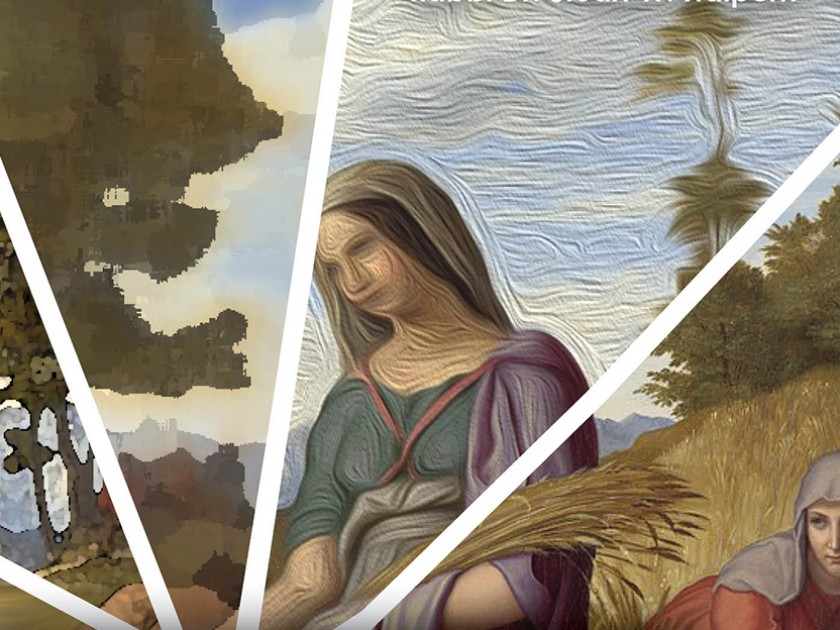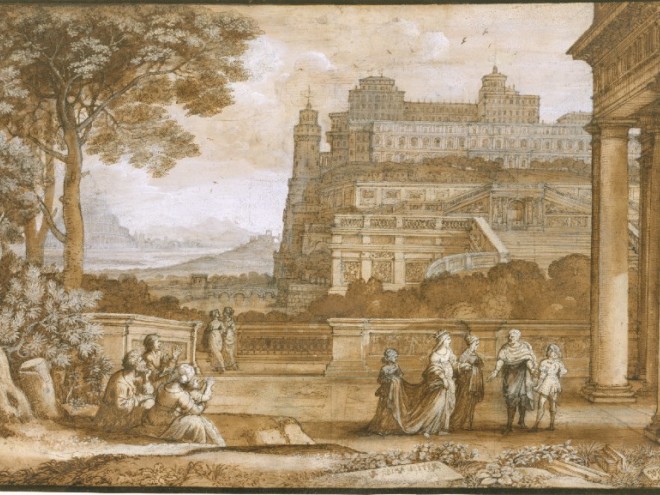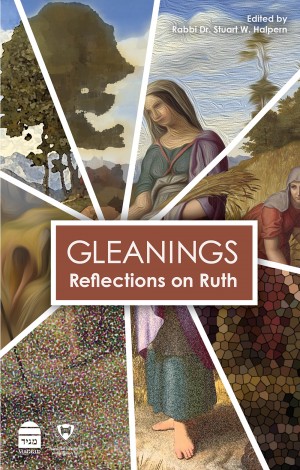
Like all such biblical lists, the final verses of Ruth list male progenitors. However, prior to those last few verses, the narratives offer what some have suggested is a female genealogy as well, one whose allusions offer even greater insight into the story of King David’s birth. In this scene, in which Ruth is married to Boaz, the names of certain female biblical heroines are evoked:
And all the people that were in the gate, and the elders, said: “We are witnesses. May God make the woman that is coming into your house like Rachel and like Leah, those two who built the house of Israel; and be worthy in Ephrat, and be famous in Bethlehem; and may your house be like the house of Perez, whom Tamar bore to Judah, of the seed which God shall give you of this young woman.” So Boaz took Ruth, and she became his wife; and he was intimate with her, and God gave her conception, and she bore a son. And the women said unto Naomi: “Blessed be God, who has not left you this day without a redeemer, and let his name be famous in Israel. And he shall be for you a restorer of life, and a nourisher for you in your old age; for your daughter-in-law who loves you, who is better to you than seven sons, has borne him.” And Naomi took the child, and embraced him, and became his nurse. And the women her neighbors gave it a name, saying: “There is a son born to Naomi”; and they called his name Obed; he is the father of Jesse, the father of David. (4:11 – 17)
This is the only time in the entire Bible where characters are blessed through the invoking of female characters. Ruth is mentioned as an analogue to none other than Rachel and Leah, two foundational biblical women, mothers and wives. In this radical acceptance of a stranger, a Moabite widow becomes an honorary biblical matriarch. In the coda of Ruth, the invocation of Rachel and Leah, as well as Tamar, is more than a simple reference to memorable female biblical characters. All three of these earlier women, along with the daughters of Lot, have been subtly alluded to over the course of Ruth’s tale. All of them, like Ruth, ensured the viability of their family line through personal sacrifice in the form of “bedtricks” of varying degrees of deception and morality. After fleeing the destruction of Sodom, the daughters of Lot made their father drunk and slept with him, thereby producing Ammon and Moab, the latter of which is Ruth’s ancestor (Gen. 19). Leah was switched for Rachel on Jacob’s wedding night (Gen. 29:25) and the two sisters often fought over their husband, once trading a night with Jacob for mandrakes (30:16). And Tamar dressed as a veiled harlot and slept with Judah (ch. 38).25
However, as contemporary scholar Ruth Kara-Ivanov Kaniel emphasizes, Ruth and Boaz’s story stands both among and beyond those earlier narratives.
In contrast to the masculine list, which is summarily “historical,” the feminine list is portrayed as “herstory” and as part of…Boaz and Ruth’s wedding scene. This list functions as a connecting link for the formal closing of the book and a disposition to recast forbidden actions into “an expression of blessing” is prominent in it. Absent here is the unforgiving terminology found in the original story: the figure of the qedeisha or the prostitute at the entrance of Enaim, the problematic revelation at Boaz’s feet, and the hesitation of the redeemer to corrupt his inheritance, the threat of the world’s annihilation in the story of Lot’s daughters and their abandonment to be raped in the beginning of the story of Sodom, the poverty, calamity, and death that accompany Ruth and Tamar, the clashing of the sisters Rachel and Leah. All of these are transformed into unified harmony in the mouths of the congratulators at the city’s gate. (Holiness and Transgression: Mothers of the Messiah in the Jewish Myth [Boston: Academic Studies Press, 2017], 14)
Through their mention in this story, these earlier women are woven into the fabric of Israel’s royal history, and their sacrifices reach an apex in Ruth’s actions. Whereas those earlier stories were tales of deceit, lack of knowledge, seduction, and trickery, Ruth’s “bedtrick” at the threshing floor was a call to action that necessitated recognition and awareness on the part of the individual actors, and that resulted in “fully legitimate, legally certified” marriage. From Lot’s daughters’ incest, to Rachel and Leah’s wedding night switch, to Tamar’s disguised harlotry, we have progressed, finally, to a public marriage ceremony at the city gates of Bethlehem. Through Ruth, those earlier episodes are thus redeemed, affirmed, and celebrated. Maybe this is why the male genealogical list that ends the book begins with the name Perez, which means “breach.” Daring to breach propriety for the sake of family, these women not only ensured the continuation of their family line, they provided national salvation.
By telling the story of King David’s genealogy through the Book of Ruth, the text is offering a nuanced framework for thinking about our own history, both national and familial. As psychologist Dr. Lisa Miller has demonstrated, the ability for families to articulate their struggles and challenges builds resilience among their members. Through the tale of a foreign, marginalized widow, whose personal risk mirrors that of other biblical mothers, we are reminded of the sacrifices that sustain the continuity of the Jewish people. We are reminded of the ability of kindness to heal. And we are reminded of the power of family, both biological and beyond. Ruth’s story inspires us to meet the challenges of our own circumstances. Through the tale of communal openness to a disconnected stranger, we are given the keys to redemption. After all, it is the eventual offspring of Lot’s daughter, Rachel and Leah, Tamar, and Ruth, with a family bloodline of struggle, alienation, and foreignness, coupled with selfless dedication to continuity, who is uniquely suited to lead the Children of Israel and bring the nations of the world closer to God. Like Moses, whose virtues and leadership abilities were developed through his fractured, foreign experiences in both Egypt and Midian, Ruth too embodies the marginal figure’s messianic capabilities.
It is through our own striving to survive and flourish alongside our imperfections, struggles, and feelings of disconnectedness that we will eventually repair a fractured world. To quote Rabbi Tzadok HaKohen in his discussion of the Messiah in his book Tzidkat HaTzadik (#111), “the lowest will become the highest.”
This is why Ruth is the progenitor of the Messiah, because the Messiah is the ultimate meishiv nefesh (Ruth 4:15), restorer of life and dignity when hope seems lost…to restore the name (Ruth 4:5) is to reach across the generations, and across interpersonal divide, and at times across the divide between aspects or periods within one’s own self, in active recognition, provoking true transformation. That is what compassionate redemption means…in the end, Ruth reminds us that nothing is more beautiful than friendship, that grace begets grace, that blessing flourishes in the place between memory and hope, that light shines most from broken vessels. What else is the Messiah about? (Nehemiah Polen, “Dark Ladies and Redemptive Compassion: Ruth and the Messianic Lineage in Judaism,” in Scrolls of Love: Ruth and the Song of Songs, ed. Peter S. Hawkins and Lesleigh Cushing Stahlberg [New York: Fordham University Press, 2006], 69, 74)
In our striving to embody the values inspired by Ruth, may we merit the writing of the next chapter of the Jewish story. May we, as individuals, as members of our family, and as members of the Children of Israel, bring the world compassionate redemption.
Adapted from “It’s in the Gene(alogy): Family, Storytelling, and Salvation” in Gleanings: Reflections on Ruth (Yeshiva University Press and Koren/Maggid Publishers, 2019), edited by Rabbi Dr. Stuart W. Halpern
Dr. Stu Halpern is Senior Advisor to the Provost of Yeshiva University. He has edited or coedited 17 books, including Torah and Western Thought: Intellectual Portraits of Orthodoxy and Modernity and Books of the People: Revisiting Classic Works of Jewish Thought, and has lectured in synagogues, Hillels and adult Jewish educational settings across the U.S.



